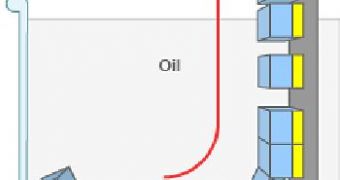Drawing inspiration from how to use a salad dressing, experts managed to create a cheap, efficient and very simple method of making solar cells that self-assembled on a variety of substrates. The new technique relies heavily on the fact that water and oil do not mix, and forces the elements of electronic components such as solar cells to assemble themselves at the boundaries between the two types of liquids. The work is reported in the latest issue of the respected journal Proceedings of the National Academy of Sciences (PNAS), the BBC News informs.
A number of other methods have been included in the new one, which is best used on small-scale components, University of Minnesota researchers say. The physics group there was behind the new, innovative work, which could see many production processes featuring the technology very soon. The fact that the technology can be used to produce large-scale devices from small-scale components will also aid in its acceptance into various industries, the scientists believe. An additional advantage the method has is that it can force components to self-assemble onto a range of substrates, and not just a select, expensive few.
The standard approach until now relied on gravity. Various lines were etched onto a substrate, which was then placed into a liquid, where components settled down at their designated locations. But, while these methods did register some success, they were always plagued by the same problem – they could not produce high yields and concentrations, which made it difficult for them to be employed in large-scale production processes. “That's what we tried for at least two years and we were never able to assemble these components with high yield – gravity wasn't working,” UM expert Heiko Jacobs, the leader of the research team, says.
“Then we thought if we could concentrate them into a two-dimensional sheet and then have some kind of conveyor belt-like system we could assemble them with high yields and high speed,” he adds for the British news agency. They managed to build such a system at the boundary between water and oil. The substrate is dipped into the liquid, and then gently pulled out. Small components snap neatly into place, and the method is extremely effective. According to the team, researchers were able to fit about 64,000 elements on a substrate in less than three minutes.
This work is a “clear demonstration that self-assembly is applicable across size scales. Self-assembly is probably the best method for integrating high-performance materials onto unconventional substrates,” University of Washington in Seattle Nanoengineering Professor Babak Parviz adds. What the UM team is currently working on is establishing the minimum size of components that can be used with this method, as well as the top size for the obtained electronics.

 14 DAY TRIAL //
14 DAY TRIAL //